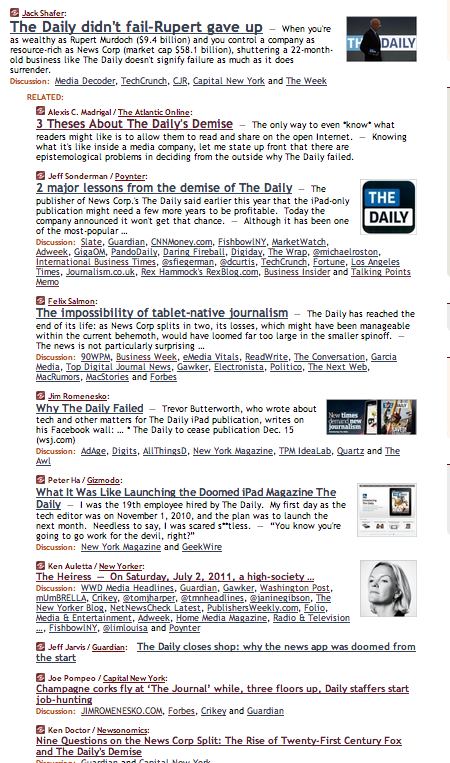Mediagazer’s biggest stories of 2012
It’s always fun for journos to argue about which news story was the story of the year. Of course, everyone has different criteria and therefore a different answer. At Mediagazer we decided to look at the data and choose visually. For us the biggest stories are the ones that inspire a variety of viewpoints and are therefore the ones that quite literally dominate the homepage with a stack of headlines.
Below you’ll see a list of the stories that caused the biggest reaction amongst media reporters and pundits. These are the story clusters that had 10 or more headlines. Some of those headlines are simply tweets that add vital information to the story as it developed but most are full news pieces. These clusters are snapshots of when the story had the most headlines so the top piece isn’t necessarily the one that best represents the cluster or the story itself, but rather is the headline that happened to be on top when the story was at its biggest.
So, who/what is number 1? Rupert Murdoch and his media properties continued to make headlines throughout 2012. From the continued fallout from the phone hacking scandal to the closure of The Daily and concurrent News Corp split, three of the year’s tallest stories bear the name Murdoch.
Since we’re looking at raw data here, we should acknowledge that these clusters can be interpreted in a variety of ways. Some might suggest that we split them into smaller stories, and we did at times. However, something like the shuttering of The Daily and the split of its parent company on the same day are clearly related. Again, these clusters don’t show the dynamic changes to the stories over the course of their development but simply the moment in time when the stories were presented as a whole.
Tragedy also took center stage in 2012, with the February deaths of journalists Marie Colvin and Remi Ochlik in Syria. The media’s reaction to mass shootings in Colorado and Connecticut also prompted important discussions about how journalists cover breaking news.
What does this tell us about the state of the industry? For me, the only way to really answer this question is to compare what is missing from this list from what’s here. The big scandals that seemed to cause so much commotion in the moment? Absent. The fabrications of writers such as Jonah Leher and Mike Daisey are nowhere to be seen. Those scandals were dramatic, but won’t have a lasting impact on the business and will be long forgotten in 2013. What will be continue to see headlines about in the coming year? The development of News Corp post split, press regulation in the U.K. and how journalists adapt to technology during breaking news situations. In other words, exactly the same things that commanded so much of our attention in 2012. Happy New Year!
1. 13 Jack Shafer: The Daily didn’t fail-Rupert gave up
2. 12 Guardian: Leveson report published – live coverage
3. 11 Lisa O’Carroll / Guardian: James Murdoch writes to MPs expressing regret over phone hacking
– 11 Telegraph: Marie Colvin killed: Syrian forces had pledged to kill ‘any journalist who set foot on Syrian soil’
– 11 Rem Rieder / American Journalism Review: Who Was First? Who Cares?
– 11 Guardian: Newsnight: executives could face disciplinary action
4. 10 Julie Moos / Poynter: How The Newtown Bee is covering Sandy Hook Elementary shooting
– 10 Dylan Byers / Politico: ABC News apologizes for ‘incorrect’ Tea party report
– 10 BBC: BBC head of news ‘steps aside’
– 10 Paul McNally / Journalism.co.uk: Murdoch: There was a ‘cover-up’ at News of the World
– 10 Jeff John Roberts / paidContent: Three questions for the New York Times Co
– 10 Tina Brown / The Daily Beast: A Turn of the Page for Newsweek